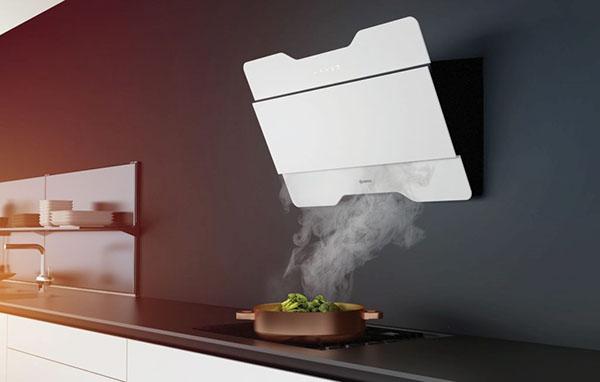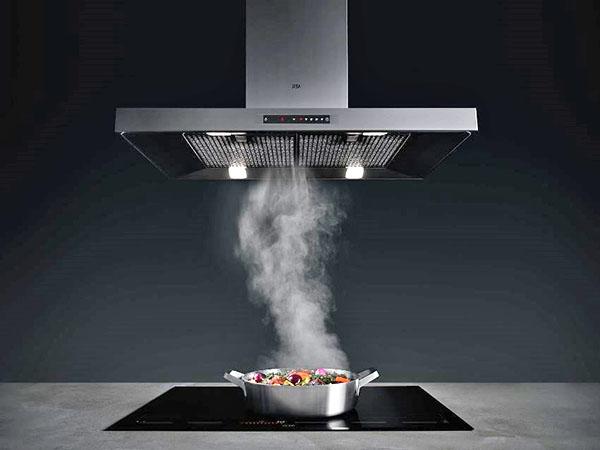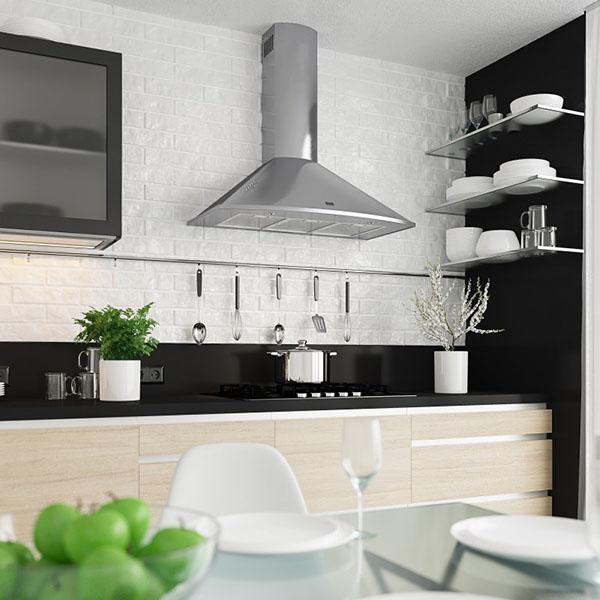Kitchen hoods - priceless "orderlies" of the apartment
 The close-knit "work" of moisture, fat and temperature leads to the formation of harmful mold and greasy soot on the walls. Kitchen hoods will help prevent the appearance of a terrible plaque, which collect all unnecessary fumes in time. Since the area of the working area is different for each kitchen, you need to choose equipment with the appropriate parameters. How do you do this and what you need to know about these installations?
The close-knit "work" of moisture, fat and temperature leads to the formation of harmful mold and greasy soot on the walls. Kitchen hoods will help prevent the appearance of a terrible plaque, which collect all unnecessary fumes in time. Since the area of the working area is different for each kitchen, you need to choose equipment with the appropriate parameters. How do you do this and what you need to know about these installations?

Cooker hoods: how they work
 During cooking, fumes, greasy soot and unpleasant odors are in the air. When all of this settles on furniture and walls, it forms an awful sticky layer. Therefore, a good ventilation system is essential for any kitchen.
During cooking, fumes, greasy soot and unpleasant odors are in the air. When all of this settles on furniture and walls, it forms an awful sticky layer. Therefore, a good ventilation system is essential for any kitchen.
Most models of electric hoods have a standard structure:
- the lower part of the body is a system of filters that collect various contaminants;
- powerful fans are built into the heart of the unit (driven by a motor);
- the structure is crowned with an air duct that is led out or to the ventilation shaft.
 Various models of this technique are equipped with additional accessories. For more powerful cleaning, they are equipped with grease traps. At the same time, incandescent lamps or energy-saving bulbs are installed on the panel. LED systems are not used in such devices, as they create a flickering effect, which is harmful to health. Air ducts are made corrugated or in the form of a square pipe.
Various models of this technique are equipped with additional accessories. For more powerful cleaning, they are equipped with grease traps. At the same time, incandescent lamps or energy-saving bulbs are installed on the panel. LED systems are not used in such devices, as they create a flickering effect, which is harmful to health. Air ducts are made corrugated or in the form of a square pipe.
The body of the equipment is made using thin layers of metal or composite material. There is no significant difference between them, so you can choose any.
Types of kitchen hoods: 3 options to choose from
 Depending on the layout of the kitchen and its interior, exhaust structures are of 4 types: built-in, dome, hinged (wall) and corner. In some cases, T-type island models are installed. How effective the hood will be in the kitchen depends on its power and the way of air purification. There are 3 types of such installations in total:
Depending on the layout of the kitchen and its interior, exhaust structures are of 4 types: built-in, dome, hinged (wall) and corner. In some cases, T-type island models are installed. How effective the hood will be in the kitchen depends on its power and the way of air purification. There are 3 types of such installations in total:
- Flowing. The units absorb contaminated vapors, purify them and discharge them through an air duct outside or into a ventilation duct.

- Recirculating. Compact devices filter the air, and then return it to the room as purified. Cleaning includes 2 stages: first, heavy particles are collected, and at the final stage, coal particles.

- Combined. The technique can work simultaneously in 2 modes. The required program is set using a special switch.

Manufacturers offer two options for grease filters: single and reusable. The latest models are made of stainless steel and have to be cleaned regularly. Disposable filters cannot be washed; they must be recycled.
Expensive models of recirculating kitchen hoods are equipped with a deep cleaning system. They have carbon filters installed in special cassettes. They absorb not only vapors, but also all pungent odors. To change them, you need to use the instructions.
 The power of the hood should be maximum so that every 5 minutes the technician can clean the air in the room. Despite their ease of use and availability, recirculation plants are less efficient. Which model of ventilation structures is suitable for a particular kitchen?
The power of the hood should be maximum so that every 5 minutes the technician can clean the air in the room. Despite their ease of use and availability, recirculation plants are less efficient. Which model of ventilation structures is suitable for a particular kitchen?
Calculation of the performance of a kitchen hood: "the formula in the studio"
 The main role in the installation is played by the engine, which drives the cleaning mechanism. The result of the device's operation directly depends on its power. To maximize the potential of technology, you need to make the correct calculation of the performance of the hood in the kitchen.
The main role in the installation is played by the engine, which drives the cleaning mechanism. The result of the device's operation directly depends on its power. To maximize the potential of technology, you need to make the correct calculation of the performance of the hood in the kitchen.
There are 3 simple formulas for such calculations:
- the coefficient 10 or 12 (number of cleanings per hour) is multiplied by the kitchen area (S) and the ceiling height (h);
- all previous values are multiplied by 1.3 or 1.6 (the coefficient of loss of productivity associated with the structural features of the building and the duct);
- 15% is also added to the total, taking into account that the device will not work at full capacity.
Modern exhaust systems are capable of filtering from 180 to 700 m³ / hour. They can operate on 2 or 4 programs, which greatly simplifies the choice of a cooker hood according to the parameters suggested by the manufacturer.
 The resulting figure is the maximum value of how much air the system can purify per unit of time (m³ / hour). However, it must be borne in mind that there is also furniture in the room, which takes up most of the space. Therefore, this indicator is only relative. In addition, the size of the room also affects the calculation of the hood for the kitchen. In small apartments, all kinds of odors spread 3 times faster than in more spacious ones. This means that the technician will have to use all its power to cope with such a flow of air. Therefore, it is better to use more powerful models in small kitchens.
The resulting figure is the maximum value of how much air the system can purify per unit of time (m³ / hour). However, it must be borne in mind that there is also furniture in the room, which takes up most of the space. Therefore, this indicator is only relative. In addition, the size of the room also affects the calculation of the hood for the kitchen. In small apartments, all kinds of odors spread 3 times faster than in more spacious ones. This means that the technician will have to use all its power to cope with such a flow of air. Therefore, it is better to use more powerful models in small kitchens.
 To the question of how to choose the performance of the hood for the kitchen, it is necessary to add a few more points. When choosing flow-through models, the throughput capacity of the ventilation ducts plays an important role. A more powerful electric motor is needed to expel air through narrow and dirty openings.
To the question of how to choose the performance of the hood for the kitchen, it is necessary to add a few more points. When choosing flow-through models, the throughput capacity of the ventilation ducts plays an important role. A more powerful electric motor is needed to expel air through narrow and dirty openings.
Other technical characteristics of kitchen hoods: what to look for
 Having considered the configuration and performance of the equipment, it is also necessary to take into account its other features. The noiselessness indicator should be in the range from 40 to 45 dB, otherwise it will harm the health of the hostess. For ease of use, touch, slide and button control panels are often installed on the case.
Having considered the configuration and performance of the equipment, it is also necessary to take into account its other features. The noiselessness indicator should be in the range from 40 to 45 dB, otherwise it will harm the health of the hostess. For ease of use, touch, slide and button control panels are often installed on the case.
At the same time, the size of the hood and its installation must comply with certain standards:
- the exhaust unit and the plate are chosen of the same dimensions;
- the distance from the working surface to the equipment is at least 75-85 cm, for electric stoves - 65-70 cm;
- the duct is mounted with a minimum number of bends and elbows, because each of these formations reduces productivity by 5%.

When choosing a hood, it is necessary to take into account the design of the kitchen set. Island models, as well as built-in structures, wonderfully fit into the high-tech style. For Provence and country, dome-type designs are suitable.
 To increase the permeability of air through the chimney, its walls should be smooth, and the diameter of the hole should be as large as possible. Unfortunately, corrugated products with their ribbed surface significantly delay the flow rate. The listed technical characteristics of kitchen hoods will help you make the right choice. However, sales assistants may advise installing an anti-return valve in the kitchen. What is it and is it needed?
To increase the permeability of air through the chimney, its walls should be smooth, and the diameter of the hole should be as large as possible. Unfortunately, corrugated products with their ribbed surface significantly delay the flow rate. The listed technical characteristics of kitchen hoods will help you make the right choice. However, sales assistants may advise installing an anti-return valve in the kitchen. What is it and is it needed?
Force majeure or why you need an anti-return valve
 This part is available either in the form of a lattice or a spinning butterfly. It can be metal or plastic.An anti-return valve is installed inside the air duct, which is mounted to the ventilation shaft or to the window.
This part is available either in the form of a lattice or a spinning butterfly. It can be metal or plastic.An anti-return valve is installed inside the air duct, which is mounted to the ventilation shaft or to the window.
Why is it needed? There are times when the air flow sharply changes its direction and the draft goes into the apartment, and not from it. This is mainly due to the strong gusty wind. In such force majeure situations, the anti-return valve for the exhaust is activated and directs the flow in the desired direction. It also neutralizes all unpleasant odors that come from the street and protects the kitchen from the icy wind.
There are 3 types of such devices:
- Membrane. Thanks to a special film, air is allowed to flow in only one direction.

- Lobed (butterfly). They are presented in the form of 2 wings. When air masses move, they either open or close.

- In the form of blinds. This element consists of several plates. When reverse thrust occurs, they move from open to closed, blocking uncontrolled wind movement.

These devices create additional and more efficient air purification in the kitchen. For this reason, when purchasing an exhaust system, some decide to choose an effective anti-return valve.
Now users know exactly what their cooker hood should be. They can easily calculate its performance, taking into account the area and height of the ceiling, as well as the coefficient of sanitary standards (10-12). In doing so, they must take into account the dimensions of the device and the gas / electric stove. Taking all this into account, the buyer will make a choice that they will not regret later.